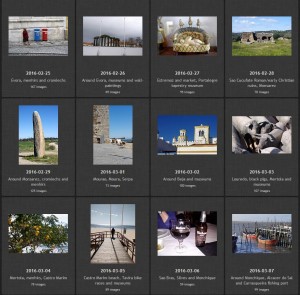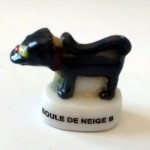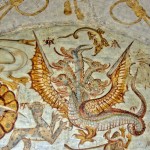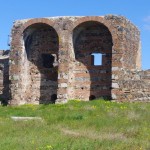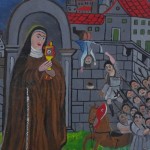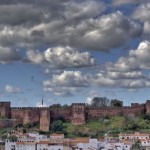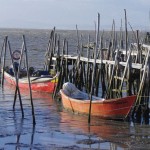To download a printable PDF version (no pictures)
click on this link E2E2016no1.pdf (six A4 pages)
Click here for the full set of Portugal photos
A week ago today we were in Strasbourg for the first time in six months, and not for routine medical appointments but for pleasure – lunch with friends. They had chosen one of their favourite venues, the Fink’Stuebel, a typical Alsace small restaurant alongside a canal, in the area of Marie Laure’s student days. Wherever we meet up, we seem to attract noisy diners at neighbouring tables – or is it just a sign of increasing age? After a congenial lunch with typically generous portions of choucroute for John and black sausage, apple and onions for Helen (Marie-Laure and Christian having chosen their favourite calf’s head in sauce), followed by an ice cream kougelhof, we were happy to walk off the excess and enjoy the relative silence in the streets of Petite France and the Grande Île. It was a lovely sunny day, despite the wind, and the atmosphere felt very relaxed, with people strolling by the river, browsing the second had bookstalls on Place Gutenberg, riding bikes and sitting with dogs in the sunshine of Place Kleber. We had forgotten how attractive the narrow, colourful pedestrian streets round the cathedral are, with their bakeries, restaurants and charcuteries. We lingered in a recently renovated boutique arcade, an excellent foreign language bookshop, and even an Oxfam shop. We saw only two armed soldiers during the whole afternoon. It was so good to feel that the security atmosphere was less tense than it had sounded over Christmas, and in February when Marie-Laure had written about a demonstration of 15,000 Kurds, the armed soldiers patrolling in groups of six, and of feeling dispossessed of their city. But now with the terrible news from Brussels and plots in Paris, that relaxed atmosphere we were lucky to experience will no doubt have evaporated again.
In our last newsletter, perhaps we underestimated the shock of villagers to the far-off events in Paris. After an enjoyable Christmas and New Year in Letchworth with family and friends, and having avoided catching nasty colds or ‘flu there this year, we returned to Entre-deux-Eaux on 7th January, in time to continue festivities here. The following evening Mayor Duhaut offered his voeux, or seasonal greetings, and those of the municipal council to the villagers in our spacious village hall. This is always well attended, with its tasty nibbles and crémant d’Alsace/kir (few people turn down good food and drink here, even if it means listening to the mayor’s speech first). We dutifully got round at least half the room kissing cheeks and shaking hands and muttering “Meilleurs voeux”, which is a record for us (especially as they only tell you after exchanging kisses that they’ve got a terrible cold). The mayor started his speech by remembering the events of Charlie Hebdo a year and a day ago, and the shootings in and around the Bataclan in November, and all who had died there. Usually it is only those who have died during the year in the village who are remembered, and in comparison the passing away of the oldest inhabitant, gentle Lena, in her nineties, seemed such a natural event. On a lighter note, the nibbles were so good and copious that afterwards we saved most of our planned dinner for another day.
Saturday was equally festive in Sainte Marguerite for the crémant d’Alsace and galette des rois. The dancing was in full swing by the time I got there, and there was much hilarity over a game involving a king, his queen, their coachman, their four-wheeled carriage and two horses participating in a story in which the nine “actors” have to get up and run round their chairs whenever their “character” (including each wheel) is mentioned.
And just in case the weekend felt quiet, there was a very convivial lunch the next day back in E2E for all the over 65 year-olds offered by the village council. There were about seventy eight participants at two long tables. The food was all cooked by a young man from the village and the music and entertainment was provided by two elderly villagers in tight jeans, joined occasionally by a man who’d annoyingly brought his castanets with him. The food was excellent, with the meal lasting from mid-day till nearly six when the coffee and chocolates were served. Each course was filling, but with all the wine and dancing between courses, everyone managed to eat their way through the menu without too much of a struggle. The highlight was a game involving a king, a queen, a coachman… it must be this year’s “in” French party entertainment. After so much wine we all had tears in our eyes as we watched the left rear wheel forgetting her part and the coachman falling off his chair. And then there was the stand up/sit down action song. Oh, such hours of innocent fun.
There was then a slight lull in January festivities, during which we were able to enjoy some snowy, but slippery walks, a local history talk on the military postcards of Adolphe Weick of Saint Dié during the first world war, and, with Scrabble in Sainte Marguerite starting to meet fortnightly rather than weekly, I bravely joined the Remue Meninges group which meets on alternate weeks. John translates it as Helen’s gaga group but it is usually translated as brainstorming, though it’s really word and number exercises like Countdown, word-search, crosswords etc. to keep the brain active. The group turned out to be very lively and welcoming and most solicitous that I should understand everything – I struggle more with the numbers than the words, oddly enough! At the end of that first session there was more galette des rois and cider or crémant!
Then on 20th we reached the final seasonal lunch, prepared by the ex-fireman’s wife and her helpers for the E2E Oldies club. John nobly agreed to join in, and by the time the wine had flowed freely, thanks to the presence on our table of both present and former mayors, John even wore the cardboard crown presented to those who found the fève (once a bean but now a ceramic figure) in their galette, and agreed to submit to the challenge of three-sided dominoes. At the same time we heard animated discussions from the mayors former and present of current village plans, like that to build a smaller meeting room for groups like ours and some single-storey pavillons or detached houses, providing disabled access for elderly villagers. This sounds a very progressive scheme for the village, but with Mayor Duhaut’s mother Giselle (the elder sister of Madame Laine) having suffered many falls in her draughty old farmhouse, he is fully aware of the problems of the elderly (a polite translation of John’s comment, “guess who’ll get the first house”).
With the feasting over, it was back to snowy walks and the occasional cultural highlight, like a talk by author Philippe Claudel, organised by the Saint Dié bookshop and held in a room at the top of the interestingly sculptural Tour de Liberté. I hadn’t realised that one was expected to reserve a place, but was graciously allowed to join other improvident people perched on tables round the edge of the room. It was perfectly comfortable, but I must have looked decrepit as I was singled out just before the start for a vacant chair in the front row alongside the dignitaries. But from there the view through the long glass windows (which curl round in a huge semi-circle) to the high snow-covered hills round Saint Dié was lovely, and especially apt when the author described writing about mountains. His main theme, however, was death and who one writes for after the people for whom one has been writing die. It wasn’t a book which I felt the urge to buy, but the talk was stimulating, so when we found the Oxfam shop in Strasbourg (there are two in Lille and Paris and one in Strasbourg), I bought an earlier novel of Claudel’s. The following weekend, however, at the Philomatique’s AGM, I invested in a fascinating and surprisingly weighty book about civilian life in the Vosges during World War 1. As a result of the tables in it I can now tell you how many rabbits and chickens there were in E2E, and the level of war damage, but it will need some close scrutiny (the print is too small for comfortable reading) to tell you the effect locally of wartime textile strikes. Unsurprisingly, it started life as a thesis and is very thoroughly researched.
No newsletter is complete without a detailed food description. Once into February, and feeling the effects of the end of the feasting, we decided to cross the Vosges to try out a new restaurant in Ammerschwihr which had been opened by chef Julian Binz (who had one Michelin star at a Colmar restaurant). His décor of voluptuous Rubens-like ladies and the head waiter simpering “you’re welcome” at the end of every sentence were negatives, but the nibbles were good, the crab amuse-bouche exquisite, and the sea bream tartare in parsnip soup with lemon grass beautifully and delicately flavoured. After that the veal in a rather strongly-smoked bacon wrapping and artichoke was good though not as exciting and the pineapple dessert was pleasant but not memorable. Afterwards we wandered round the small walled town of Kientzheim before driving back. There were illuminated warning signs as the road started the climb to the Col de Bonhomme, and we passed a snow plough spreading salt or grit on the Alsace side, but our side had not been done and the van in front was going extremely slowly as the compacted new snow was slippery near the top.
Other February diversions included an antiques fair then the big Amnesty book sale in Saint Dié and the annual trip to the “theatre” in Saulxures. This year’s farce had just 3 local actors (including the baker) in a ménage à trois, and before performing they also waited at table, carved the giant smoked ham, poured the drinks and chatted to guests at the long tables, all of which get the audience in a very receptive mood for the comedy. They do a Saturday and a Sunday performance and meal right through winter from October. Such a hard slog on top of a working week!
After that February began to seem a bit drab, and John searched the internet for a good combination of cheap flights and maximum winter sunshine and on 24th we flew from Basel to Lisbon, hired a car and meandered south and east. Many years ago (probably over thirty-five) we’d taken the train from Lisbon to Lagos in the south west for a few days at the end of a conference John was attending. The small fishing town had charmed us, as had our ride across the Tagus on the ferry and the train through the cork estates. This time, not wanting to see all the high rise hotels and flats that have since blighted that coastline, we decided to head south east, the car enabling us to visit more remote places and see ancient rural megaliths, as well as the rich layers of Iron age, Palaeo-Christian, Roman, Moorish and Christian sites in fortified hill towns. Evora was our first stop. We stayed just outside the town walls, but from the top floor bar we could see the town spread out above us, dominated by the stolid Romanesque/Gothic cathedral. Beyond, in the countryside we walked up earth tracks between cork and olive trees and grazing cattle to find early history’s atmospheric menhirs and dolmens. On a wet day we dashed with dripping umbrellas between the museum’s Iron age and Roman finds, the Roman temple and baths, and churches with blue and white tiled interiors, and then were intrigued by a small metallic notice on Vasco da Gama street about the ancient palace of the Silveira-Henriques with remains of a sixteenth century cloister with “frescos where the bizarre, the grotesque, the profane and the religious thematic enters in symbiosis in a marvellous allegorical set, enhancing an artistic manifestation unique in the country”.
There was nothing in the various guide books about this unique allegorical symbiosis. Who could resist the challenge? But there were no likely-looking palace doors. We walked uphill and into a square and enquired tentatively in the gallery of modern art. They said they could access the “garden”, but were more interested in showing us the current artists’ exhibitions. Eventually, escorted by a guard with keys and a silent custodian, we were ushered along a corridor, down stairs, through a crypt, up some more stairs and the gate into a small garden was unlocked for us. And there along one recessed wall of the garden were the most delicately painted enchanting creatures from a mediaeval bestiary, including a many headed dragon or hydra, a mermaid and a musician. We felt as excited as if we had discovered them ourselves, and on the way out smiled politely at the torn splattered bed-sheet modern artworks we were shown, whilst feeling, like old fogies, that art isn’t what used to be.
None of the frescoes we saw afterwards, amid the fortifications, would match the delicacy of what the hotel barman called “the painted garden”. On our way to the lakeside walled hill town of Mertola close to the Spanish border, we made a detour to a Roman villa marked on our map. São Cucufate (a Spanish saint said to have survived being roasted alive, covered with vinegar and pepper) in fact exhibits the remains of three very large Roman villas (the massive walls of the latest dating from the fourth century) and a ninth century convent. Sadly the Augustine canons, or the Benedictine monks or the solitary hermit who later occupied it were not as skilled at chapel wall-paintings as the “garden” painter.
But nothing as sad as the frescoes at the tiny sixteenth century village church of Santa Clara de Louredo, where we stopped on our way between the walled town of Beja and the fortified hill village of Mertola, having read a passing reference to a legendary princess repelling the Moors. It is possible that the paintings on the walls round the altar were very crude to start with, but their “restoration”, apparently in the nineteen eighties, looks balder than a comic strip with black outlines and crude daubs of colour depicting Saint Clare, holding up the sacrament and saving her convent and the walled city behind from the Moors. We were cheered only by the sight of a troupe of the famous Iberian black pigs a bit further along the road rushing eagerly through the olive trees in the hope that we would feed them titbits through the roadside fence.
By the time we reached Mertola it was the hottest day so far as we climbed up the steps to the old walled town and sank into café chairs and waited for everything to open after lunch. This was probably our richest day as with an old river trading port through the ages there were all the afore-mentioned layers of history, with Phoenician and Greek artefacts thrown in. Below the castle walls were some fascinating recent excavations of Moorish houses built on the Roman forum, with an episcopal palace alongside. The simple adjacent church had been a mosque, the castle of the Swabians and Visigiths and Moors was taken by the Spanish Knights of the Order of Santiago, and there were fascinating little Islamic, Roman and Palaeo-Christian museums to visit. The impressive Roman house remains were to be found under the town hall, approached through a typically boring municipal waiting room. Even our modern hotel had a viewing shaft in reception down to the walls of the fishermen’s houses excavated during its construction.
And when we reached the coast near Castro Marim and the Spanish border the next day, it was still hot enough to enjoy a paddle along the windy golden sands of the deserted beach. More energetic were the cyclists racing in over the Roman bridge in Tavira at the end of the Algarve bike race. Set back further from the coast we enjoyed the castle and cathedral at Silves, deciding that this was the Moorish fortification (formerly Roman and Visigothic) for us, with its ample water supply (a ten metre high vaulted and pillared cistern and sixty metre deep well) and its attractive modern sculpture garden.
Outside the castle gate there was live open-air music from a café and the cobbled streets leading up to the cathedral (built over the former mosque) were strewn with lavender for the pre-Easter procession later. When we reached the west coast we were enchanted by the small fishing hamlet of Carrasqueira in the evening sunlight with its simple spiky wooden jetties.
We stayed in a mix of rural guest-houses, modern urban hotels and posh historic Pousadas (including our last night in the old castle/convent at Alcacer do Sol, which of course had its own excellent subterranean museum of Iron age, Roman, and Moorish old walls and pottery fragments). And we ate a lot of good hearty pork (including those black pigs), cod, wild boar, and steak dishes (John had his best ever beef fillet in Evora, and on our last night near the west coast the riverside restaurant combined land and sea in a large plate of steak, prawns and chips). It was a great break.
Back in E2E, an agreeable spell of sunny weather has enable us to get on with weeding and pruning and fertilising the garden. Rejoicing in the improvement to his back, John has been heavily pruning trees, sawing and shredding all the orchard saplings branches he has cut down, only to discover he is very allergic to some – probably the flying golden pollen of the hazel catkins. The hellebore and snowdrops have been very pretty this year, and the cowslips, which I always associate with Easter, are stippling the orchard grass.
After Easter we shall be packing up again and heading for Letchworth, where we hope to see as many family and friends as possible before we return around 19th or 20th April. When we reached Calais on our last trip in December we saw a very large number of police in and around the makeshift migrants’ camp behind the grim wire fences shielding the approach road to the port. Then armed French police inspected our car boot as we checked in. Asked whether there had been an incident overnight, they shrugged and said it was routine now. All was quieter on the return journey, but police were still patrolling the gap between the two wire fences, which were uncomfortable reminders of prison camps. A report sixteen days later of fifty migrants breaking the barriers and boarding the P&O Ferry “Spirit of Britain” did not come as a surprise.
With that sombre thought, we wish you all a very happy Easter and hope to see you soon.
We visited many more towns, archaeological sites, castles, museums and galleries
in southern Portugal than are mentioned above
If you wish to see more photographs, click on the image below for the full set
